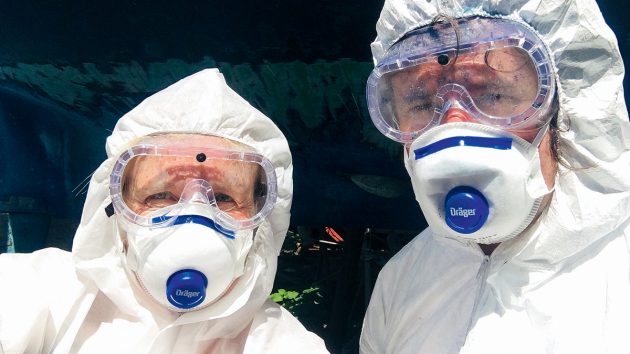We sent some photos of Maximus to three leading antifoul suppliers – Seajet, International and Coppercoat – and asked them some key questions before making a decision on the best cheap antifouling paint to use. Here’s what they said.
What’s your most economical antifouling paint?
The lower the level of fouling you’re up against, the cheaper the antifouling paint is likely to be. For low to medium fouling conditions, International recommend Boatguard 100, which starts at £60 for 2.5lt.
Seajet’s most economical antifouling paint is Seajet 031, which costs £61.95 for 2.5lt. Sales and marketing manager Emily Schreurs points out that it still contains 30% copper, and is very effective.
Coppercoat only does one product, a full-strength hard-wearing epoxy with 99% copper. The cost is currently £108 per litre and Coppercoat will let boat owners know how many litres they require and the total price for their prospective purchase (which for the PBO Project Boat Maximus, a 28ft sailing boat, would come in at around £600).
Note: We may earn a commission when you buy through links on our site, at no extra cost to you. This doesn’t affect our editorial independence.
Should I strip back to gelcoat?
Having seen our photos of Maximus the answer to this was a resounding ‘yes’ – we did need to strip her back before applying antifouling paint.
“This is indeed the best option,” said Ewan Clark of Coppercoat. “This will not only provide you with the ideal platform from which to re-coat, but will also rid the boat of the weight and drag of the dead paints, helping to restore the boat’s performance.”
Article continues below…
Best antifouling paint: 8 leading options in head-to-head test
In June 2021 we coated the hull of a Hardy Commodore 42 with eight of the best antifouling paint products.…
The great UK antifouling test for cruising yachts
20 antifouling paints tested in 13 UK locations: which works best where you keep your boat?
How long will cheap antifouling paint last?
Keeping a boat afloat for nine months and ashore for the colder three months is typical in much of the UK and northern Europe. A conventional antifoul paint should provide good protection for the nine months, but will need to be reapplied each winter until the paint thickness builds up and it needs stripping back.
“Coppercoat will save you this annual chore and expense,” says Ewan. “There are many hundreds of boats in Poole Harbour using Coppercoat, and I know of boats treated over 20 years ago. However, we still stick to our original advice, which is that you should expect a treatment of Coppercoat to provide good antifouling performance for a minimum of 10 years.”
International do an antifoul called Micron 350, which is an SPC (self polishing copolymer) antifouling. Depending on the volume applied, it offers up to two years protection.
Seajet’s 039 Platinum is their high-end antifouling and lasts two to three seasons. However, they anticipate their longest-lasting product to be Seajet Bioclean Eco.
As we went to press, this was due to be launched at the 2021 Marine Equipment Trade Show (METS). “This is a silicone product and contains no biocides at all,” says Emily Schreurs.
“One of our customers, the owner of La Loupiote, told us that in 15 years they changed the underwater paint only three times. They had to do some repairs after damage but the silicone lasted for years.”
What preparation is required before applying cheap antifouling paint?
After removing all the old paints to reveal the two-pack epoxy (or original gelcoat), Coppercoat advise thoroughly abrading the surface with 120-grit paper/discs to provide a good physical key for the new coating to bond to.

Coppercoat isn’t the cheapest antifouling paint to apply, but its longer lifespan makes it an economical option
International recommend 80-120 grit, and point out that you need to do a thorough clean beforehand. Seajet adds, “When you start scraping or wet sanding the old antifouling off, it’s wise to leave the epoxy intact. You can always apply another coat of epoxy primer.”
How environmentally friendly cheap antifouling paint?
“Coppercoat is a durable epoxy resin, not an ablative paint, so has a far lower biocidal leach rate than any other active antifoul coating,” says Ewan Clark. “The leach rate of Coppercoat comes in at only one tenth of the restrictions set by the strictest locations, such as Sweden and California.”
International point out that all their products comply with the BPR. Antifouling products are highly regulated and the Biocidal Products Regulation (BPR) is designed to improve the functioning of biocidal products in the EU, while protecting humans and the environment.
Seajet’s Bioclean Eco has no biocides at all and is part of a new Eco range launched at METS 2021.
Note: there are many other antifouling brands to consider including FLAG, Hempel, Jotun and Teamac. Read about them all in our head-to-head test of the best antifouling paints.
Thanks to our Project Boat Supporters

Dell Quay Marine, Osculati, Raymarine, Shakespeare Marine, TruDesign, Screwfix, Coleman Marine Insurance, MDL Marinas, Premier Marinas, seajet,, Clean to Gleam, West System, Farécla, Navigators Marine, RYA, Aqua Marine, Ecobat, Victron Energy, Scanstrut, T Sails and XP Rigging.
Why not subscribe today?
This feature appeared in the February 2022 edition of Practical Boat Owner. For more articles like this, including DIY, money-saving advice, great boat projects, expert tips and ways to improve your boat’s performance, take out a magazine subscription to Britain’s best-selling boating magazine.
Subscribe, or make a gift for someone else, and you’ll always save at least 30% compared to newsstand prices.
See the latest PBO subscription deals on magazinesdirect.com






